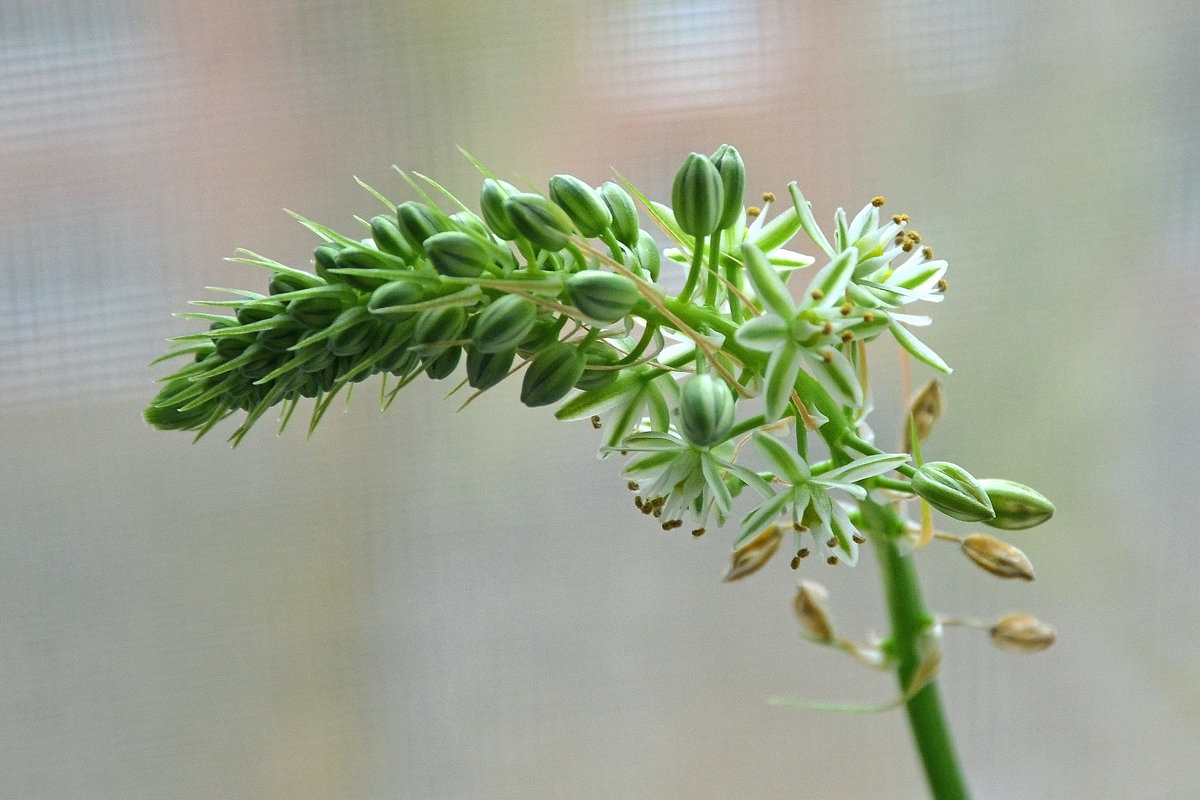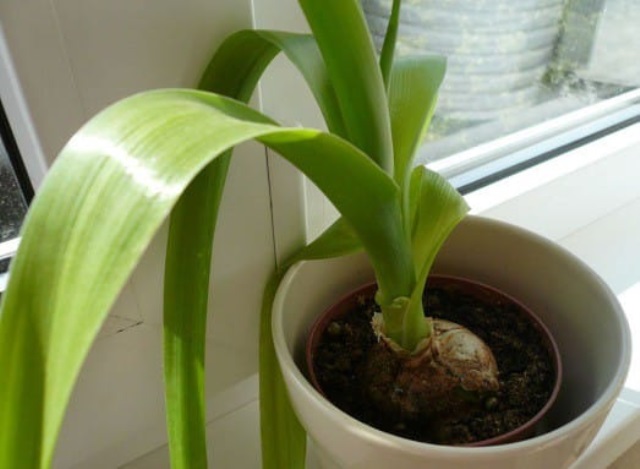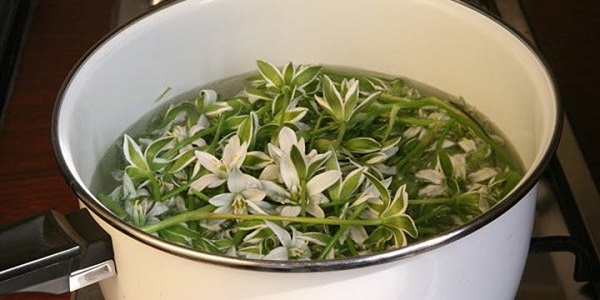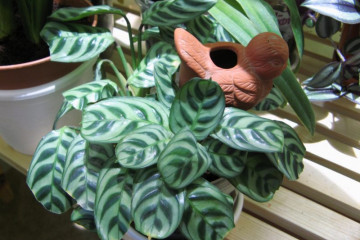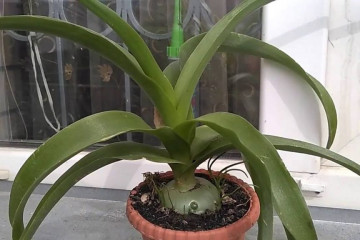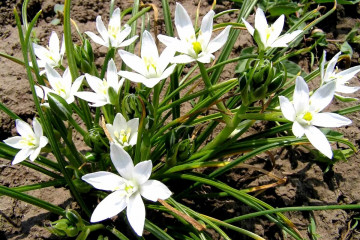Indian onion (tailed poultry) as a houseplant
Content:
The tailed birdhouse, popularly known as the Indian onion, is an exotic plant that today has become popular in indoor indoor cultivation. He has spectacular green leaves, bright flowering, and Indian onions are also useful. No wonder it is grown both indoors and outdoors.
This article tells about the properties of a "wonderful healer", as they say about him among the people, about how to grow it correctly.
Why is Indian onion good
A native of Indian onion from South Africa, difficult growing conditions left an imprint on the plant - it is very hardy and resistant. Because of its unpretentiousness, indoor floriculture lovers take Indian onions for growing at home and often breed a poultry farm, and also because the plant is exotic, has an attractive appearance and blooms for a long time.
During the flowering period, the onion throws out a long arrow, covered with discreet buds, they bloom alternately and delight the eye for a long time.
Although the flowers are small in appearance and pale in color, they can still look very good. The rest of the time, the onion is a rosette of juicy bright green long leaves that grow quickly, create a lot of greenery, and a rosette is formed from the bulb. The bulb itself looks quite original: covered with whitish-green scales, it sticks out of the ground, gradually becoming a ball, this only adds some exoticism to the plant.
It is also important that the sap of the plant, like that of many milkmen, is very burning, therefore it is used in many recipes of traditional medicine as a distraction.
Growing at home
The plant multiplies easily, quickly forming new bulbs. Therefore, many plant it not only at home, but also on the personal plot, where there is a free spot. In a garden, it grows rapidly, the roots can go deeper into the soil by a meter. For the winter, the bulbs need to be dug up, divided into children and taken to the basement for wintering.
In pots, the bulbs live peacefully and without hassle, care consists in watering, feeding, and they only need to be separated and transplanted when new bulbs are formed.
How to plant correctly
Planting is simple - you just need good drainage, a small pot and soil. A mixture of sand, turf and leafy earth in a ratio of 2: 1: 1 is best suited for the lactician. The plant is planted, like all bulbous plants, deepening the planting material by no more than a third. The rest should be on the surface of the soil.
By the way, such a planting allows you to completely separate the small baby bulbs from the adult plant without hindrance.
Care rules
Taking care of the plant is not difficult. First of all, this is watering, then feeding. Here are some basic rules of care:
- Watering regularly and in moderation is very important. In winter, water the onion only after the soil dries up, in summer more often, but without leading to root clogging. The plant may die from excessive watering. He really needs air humidity. If there is dry air in the room, which happens during the heating season, the leaves must be periodically refreshed with water from a spray bottle. Although the plant's resistance is such that even without watering it will last 2-3 months;
- The lighting should be good, but not too bright. The eastern side of the windows, the southern (slightly shaded) part and even the northern part are suitable, if you periodically bring the plant to the south side for “sunbathing”;
- Fertilizing with mineral and organic fertilizers is also important. The plant responds well to the introduction of mullein infusion. It can also be watered once a month with a weak solution of potassium permanganate and an infusion of wood ash.
By replanting an adult plant, you can grow a rather impressive bulb, framed by an abundance of greenery.
Medicinal properties and use in medicine
Indian onions have long been used in folk medicine. Treatment with tinctures and plant juice is associated with its chemical composition, which includes aromatic acids, essential oils. Some argue that the plant also contains alkaloids. The plant's accompanying pain relief effects are based on flavonoids and glycosides, which are also abundant in onions. Basically, the use of Indian onions is local, in the form of compresses and lotions, onions are valued mainly for their main property - pungency.
Diseases that are treated with Indian onions
Indian onion is able to help with various diseases, it is most effective for radiculitis, arthrosis, polyarthritis, osteochondrosis and for problems after sprains and injuries. Anesthetizes the juice of the lactarius of the place of bee stings, bruises, abscesses. Pain in muscles and tendons can also be relieved by rubbing with Indian onion juice.
The easiest way is to use fresh plant juice. So, a room milker should always be at hand for those who suffer from migraines, headaches of a different origin (the back of the head and temples are rubbed).
Among all types of Indian onions, there is one, the action of which is recognized not only by traditional healers, but also by official medicine. This is an umbrella poultry farm. Colchicine is valuable in it - an alkaloid that can treat such a complex disease as gout, as well as autoimmune diseases.
Dosage forms
All preparations made on the basis of Indian onions are poisonous, therefore they are suitable only for external use. You need to use them carefully, prepare them in strict accordance with the recipe.
Contraindications for use are:
- pregnancy and lactation period;
- bleeding gums;
- allergic reactions;
- hemophilia.
Long-term use of plant-based products is contraindicated, since colchicine helps to lower the level of leukocytes in the blood.
A decoction of the onion peel is prepared by the infusion method. The husk remaining from the onion transplant is crushed, poured into a glass of water and allowed to boil. Then they insist for 4 hours and filter.
The infusion for compresses is prepared in water. You can use a thermos or insist on a water bath. For cooking, take a sheet 20-25 cm long, chop and pour 1 liter of hot water, then hold it for another 25 minutes in a steam or in a thermos.
However, alcohol recipes are also common. To prepare a solution based on alcohol, a whole onion is taken, washed, crushed and poured into 1 liter of alcohol. It is necessary to withstand the tincture for 21 days.
Healing ointments from Indian onions are good in the treatment of purulent wounds and inflammation of the joints. The composition based on sea buckthorn is very popular:
- a spoonful of kerosene;
- 3 tablespoons of sea buckthorn oil;
- a piece of beeswax larger than a walnut;
- 2 yolks;
- onion juice (about a couple of sl. spoons).
The oil heats up, the wax dissolves in it, then, as everything cools down a little, juice and kerosene are added, at the end - the yolks. This mass can be used to lubricate a sore joint, then wrapping the place with a film and woolen cloth.
Indian onions are an interesting exotic plant that can be brought into the house and planted in the garden. Its green bright appearance, flower stem, large bulb will delight the eye and amaze guests, useful properties can be used in the treatment of many diseases. You need to remember about the precautions. This flower is as beautiful as it is poisonous.

